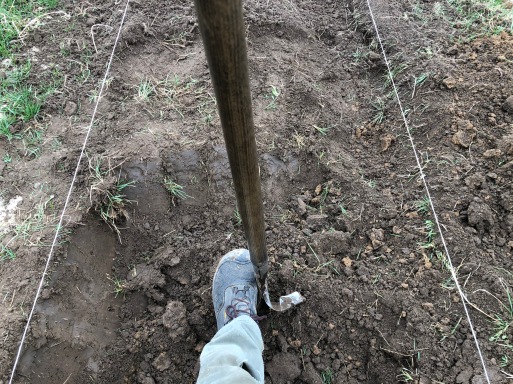Perennial Friday
Friday had the feel of a pretty festive day. Ed and I had gotten an early start, and by the time Polly showed up a few hours later, we were well into the digging of the trench for a new hugel bed. Well… I was. He wasn’t making all that much progress, but given his advanced age, I cut him some slack. We had Led Zeppelin bumping on the speaker, giving us an energetic boost through the beginnings of the physically demanding task.
“Dude, you think I should put on some Taylor Swift, just to mess with Polly when she gets down here?”
“I like Taylor Swift.”
“… Yeah, me too…”
I decided on her first album, for an additional factor of unexpectedness. Polly, unfazed, grabbed a shovel and got to digging. A fifteen-year old Taylor crooned her heart out over my Bluetooth speaker.
When you think Tim McGraw; I hope you think my favorite song..
The one we danced to all night long…
Finally. “What is this, the Dixie Chicks?”
“No, it’s Taylor Swift. Ed and I wanted to put it on to mess with you, but really we’re both fans. I’ll let it ride for another song or two if that’s cool.”
“Yeah, sometimes I don’t mind listening to music I wouldn’t have expected I’d be listening to. It’s kind of Dixie Chickish…”
Eventually, Taylor was supplanted by some weird pop-funk stuff that David had recommended, and then silence. Ed finished his tiny section of trench slightly before I finished my huge section, and gave me a hard time. We neared the completion of the digging, and I hooked up the tractor and wagon to efficiently transport the needed wood, woodchips and mulch.
The building of a hugel is a pretty simple, albeit demanding, process. Dig a 60’ long, 3’ deep x 3’ wide trench; fill in the bottom with large wood logs; fill the top with skinnier sticks; fill in the gaps with wood chips, replace the soil on top and shape the bed. It’s a permaculture method for long-term release of nutrients as the wood breaks down, inviting lots of life-giving microorganisms into the soil. We managed to build one of these later in the fall last year, filling it with perennial sage and thyme plants that had lived in trays for way too long into the season. This year, we are on track to have it ready for a timely herb planting.

So efficient were we that we loaded the hay wagon up with mulch and mulched the new bed thoroughly. Come planting time, we will simply open up divets in the mulch and transplant herbs into the mostly weed-free bed, for a low-maintenance planting. We even hoed and mulched the sage and thyme hugel from last year; hopefully all but eliminating further work requirements on that bed for the rest of the season. While we worked, Asher and Logan made strides on the interior fence line construction, and Kelly and Danny weeded and mulched our rhubarb patch as well. Later in the day, we even took care of some hoophouse and irrigation repairs; notable odds-and-ends jobs for this juncture of the season.
All this perennial freedom was due to the effort we’d put in earlier – stretching from earlier in the week, back to last fall. In the fall, we rolled up and organized our tarps sensibly and effectively, minimizing the work required to dig them out of snow and water this year. We had also filled rock-bags for tarp weights, negating the time-consuming process of digging clumps of soil. Moreover, we’d (Asher’d) devised a clean method for rolling up drip-tape, thus avoiding the messy maze of hose disentaglement which had muffed us last spring. Over the winter, I cut a good deal of wood, and staged it for use on the hugel.
Earlier in the week, we had broadforked, mulched, and hoed heavily through some nasty winds and snows; buckling down mentally and physically to open up Friday project freedom. I’d spent Thursday evening icing my hands and forearms after a ridiculous day of effort. The muscles between my fingers ached, and my resting left hand curled furtively into a claw, from the impact of its ceaseless grip on the pitch fork and broadfork handles. But we were caught up. The spreadsheet plan informed us that Friday would be a free day.

One of the primary ironies of life for the farmer is that good work begets more work. I apply this logic to nearly insane proportions; setting daily expectations near the threshold of superhuman effort. I can scarcely spend time at the farm without identifying fifteen necessary projects, and can scarcely leave prior to completion of at least eight. My ancestors on both sides were farmers, and I’m slowly accepting that this may just be the way I’m wired.
But the labor is a labor of love. I love the work and I love the land. The more efficient and effective we can be with the daily and seasonal chores of vegetable production – our bread-and-butter means for financial fluidity – the more establishment and development we can do. I have visions of our property’s eventual beauty and bounty, and understand that these realities will manifest only in the wake of our efforts and focus through the demands of the daily grind. As exciting as a new bed of onions may be, a long stretch of raspberries, strawberries, rhubarb or apple trees are all the more exciting; given their potential for sustained yield and bounty. All the better if they’re weeded and mulched. Plus, somehow, perennial work has a way of feeding the collective soul on a Friday.
